The jury's votes are in — Architizer is proud to present the winners of the 2025 Vision Awards! Join the program mailing list and continue celebrating the world's best architectural representations by clicking here.
The past few years have been difficult for most people across the world. In addition to health-related worries, people had to worry about changing work patterns, feelings of loneliness, managing finances, growing unemployment, isolating with family and even acquiring basic resources for the household.
During this time, everyone’s homes changed to accommodate more screens for work, the kids’ schooling, entertainment and more. The following eight entries from Architizer’s One Drawing Challenge look into this transforming architectural landscape and imagine new ways to break out of this isolated bubble and strengthen the connections that have been weakened over the months.
A Room is not a House or Banham’s Latest Nightmare
By Nicolas Verdejo
 In this illustration, the artist has portrayed the changing nature of the room during the pandemic, when going out wasn’t an option. Thinking about the months of isolation, Verdejo said, “Our rooms were our bubbles, the setting for every fiction or dystopia our imaginations could project, and this was as far as we could go.” The home slowly turned to adapt to include our activities done outdoors and also the space for interaction with others. Furthermore, our lives are becoming more and more dependent on technological devices, as evident in this image.
In this illustration, the artist has portrayed the changing nature of the room during the pandemic, when going out wasn’t an option. Thinking about the months of isolation, Verdejo said, “Our rooms were our bubbles, the setting for every fiction or dystopia our imaginations could project, and this was as far as we could go.” The home slowly turned to adapt to include our activities done outdoors and also the space for interaction with others. Furthermore, our lives are becoming more and more dependent on technological devices, as evident in this image.
Together Alone
By Bless Yee
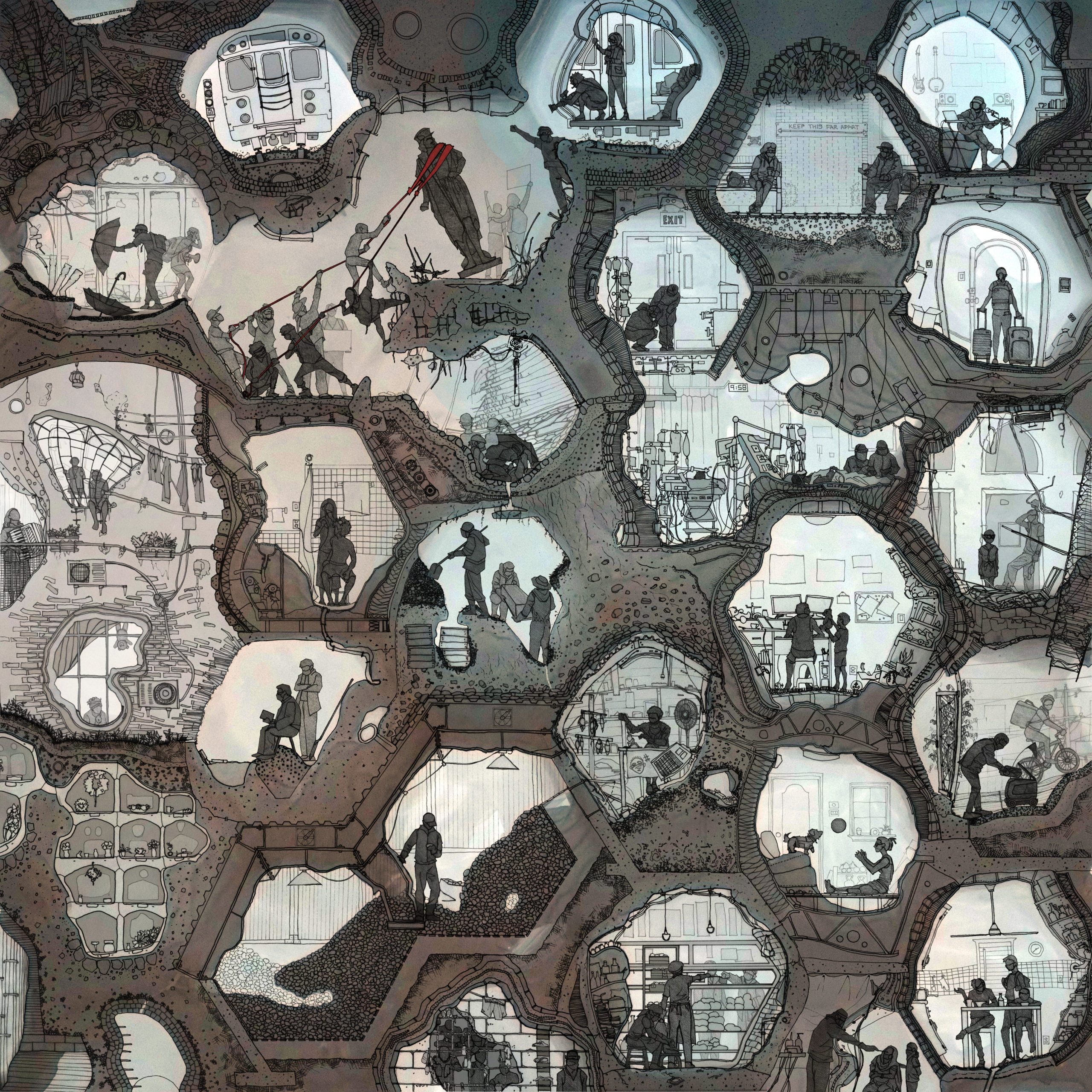 The months in isolation have changed how we communicate and gather. The idea of being together has changed. Group events have turned to virtual meetings and even the nature of work has shifted from offices to home setups. The artwork creates a montage of our daily activities in the form of a section. The creator said that the hexagonal modules “represent our self-proclaimed strength and efficiency around our designs, the same efficiency that circulated the virus with rapid speed.” The geometric framework is slowly collapsing under the pressure of constantly adapting to a new normal. The closeness of these pods to one tries to show that we are all closer than we think and collective action is the way for a brighter future.
The months in isolation have changed how we communicate and gather. The idea of being together has changed. Group events have turned to virtual meetings and even the nature of work has shifted from offices to home setups. The artwork creates a montage of our daily activities in the form of a section. The creator said that the hexagonal modules “represent our self-proclaimed strength and efficiency around our designs, the same efficiency that circulated the virus with rapid speed.” The geometric framework is slowly collapsing under the pressure of constantly adapting to a new normal. The closeness of these pods to one tries to show that we are all closer than we think and collective action is the way for a brighter future.
INSCAPE: Neo-Unité
By Hao Wang Xin Feng
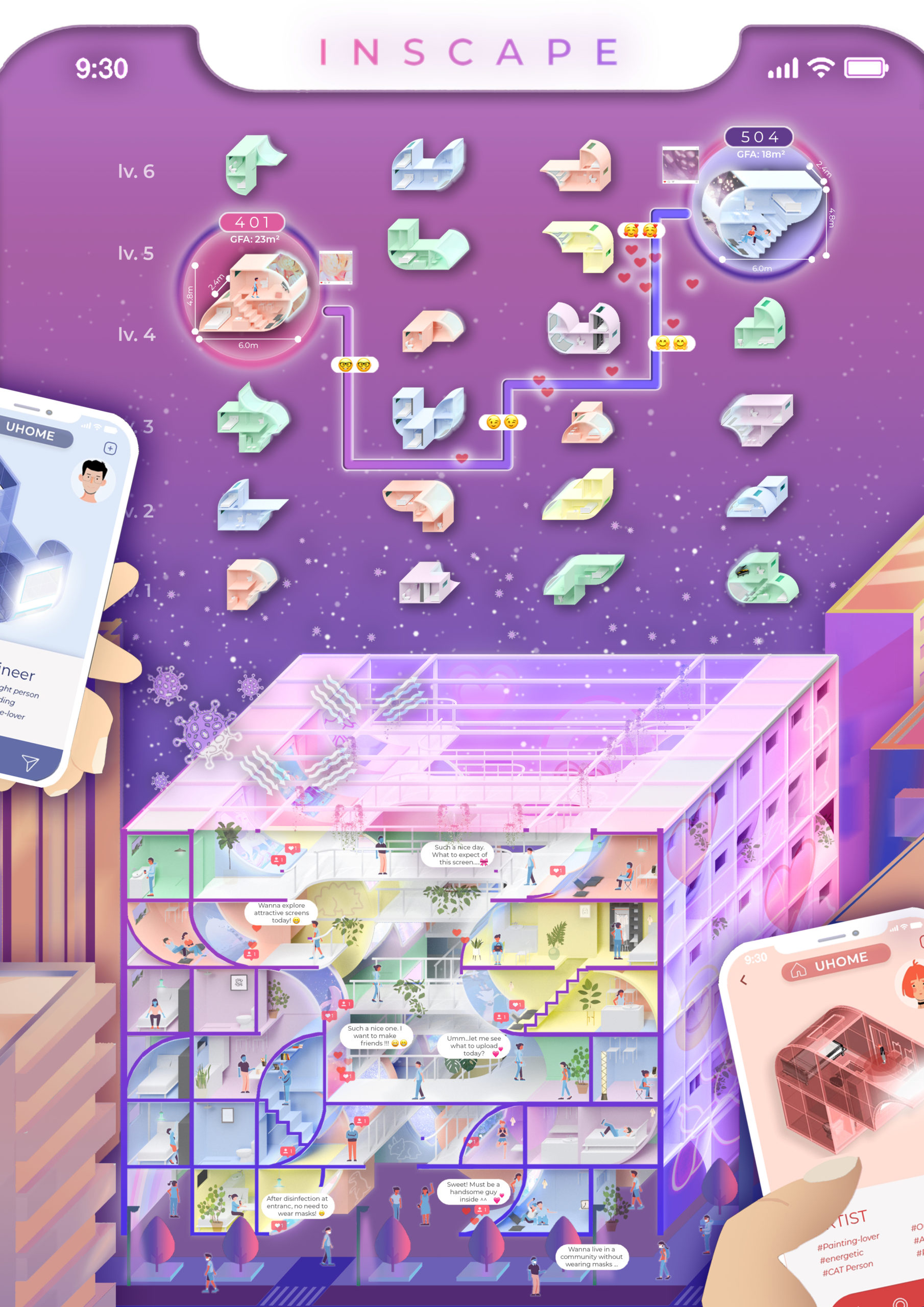 Social media as a concept has existed for years. But when physical relationships were restricted amid a global crisis, social media and virtual connections became a source of support for many. The nature of a digital platform slows users to be whoever they want to but that leads to the question of whether the digital self is the true self. The artist imagines INSCAPE as a new platform that tries to bridge the gap between true identity and social relationships. In this virtual realm, users are matched with housing units based on their personality and the screen becomes a medium for everyone to share their thoughts and feelings anonymously.
Social media as a concept has existed for years. But when physical relationships were restricted amid a global crisis, social media and virtual connections became a source of support for many. The nature of a digital platform slows users to be whoever they want to but that leads to the question of whether the digital self is the true self. The artist imagines INSCAPE as a new platform that tries to bridge the gap between true identity and social relationships. In this virtual realm, users are matched with housing units based on their personality and the screen becomes a medium for everyone to share their thoughts and feelings anonymously.
Sailing in the sea of uncertainty of a pandemic
By Daniel Laredo
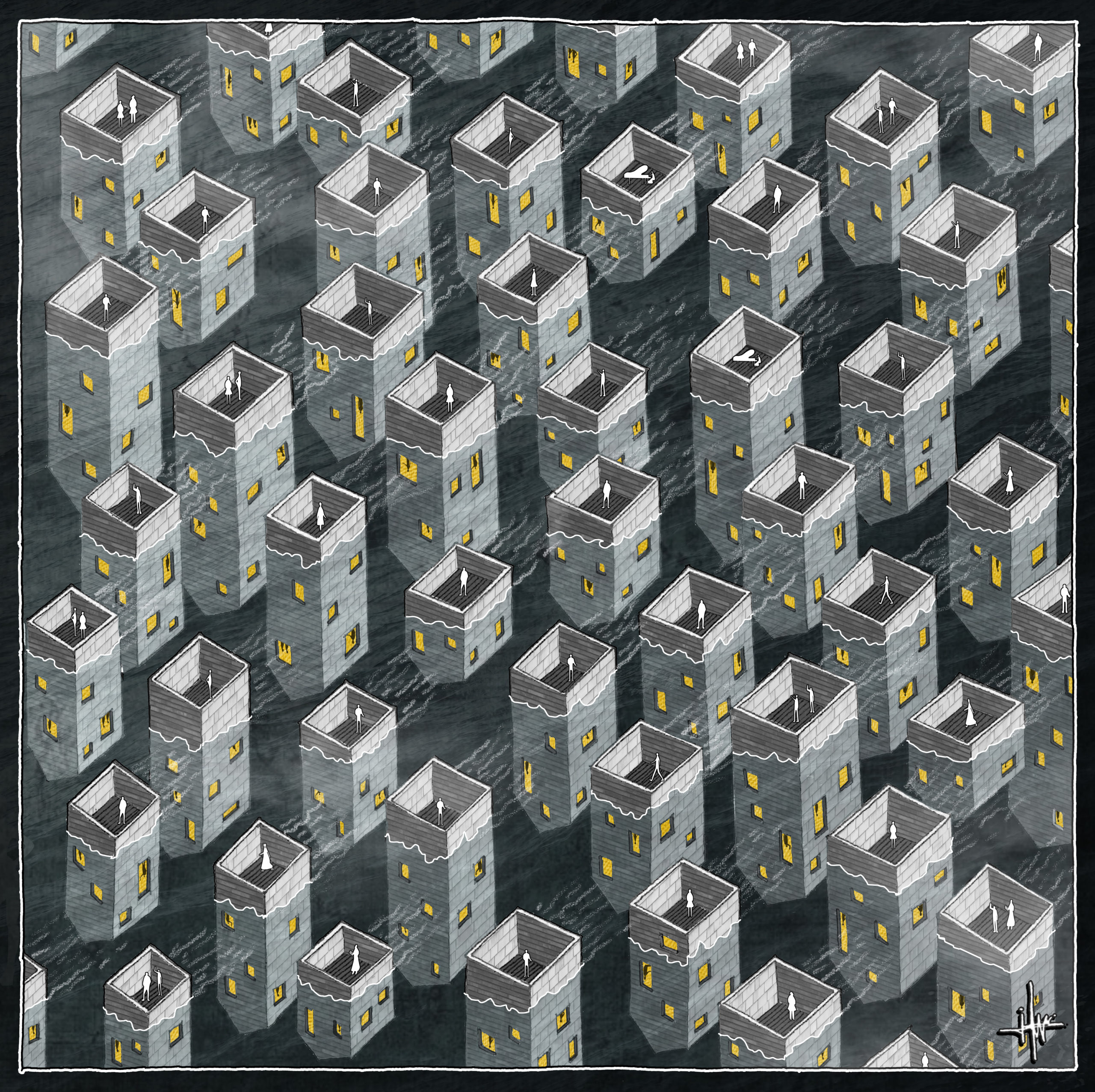 A major change that COVID-19 brought to the frontlines was the idea of remote working. Laredo has depicted his experience of remote working as a series of boat-like homes that are upside down, much like life during the pandemic. These homes hold the families of individuals Laredo collaborates with. As one can see, they are all swimming in the sea of uncertainty, together as a team that tries to keep forging ahead no matter what comes their way.
A major change that COVID-19 brought to the frontlines was the idea of remote working. Laredo has depicted his experience of remote working as a series of boat-like homes that are upside down, much like life during the pandemic. These homes hold the families of individuals Laredo collaborates with. As one can see, they are all swimming in the sea of uncertainty, together as a team that tries to keep forging ahead no matter what comes their way.
Endless Interior
By John Stoughton
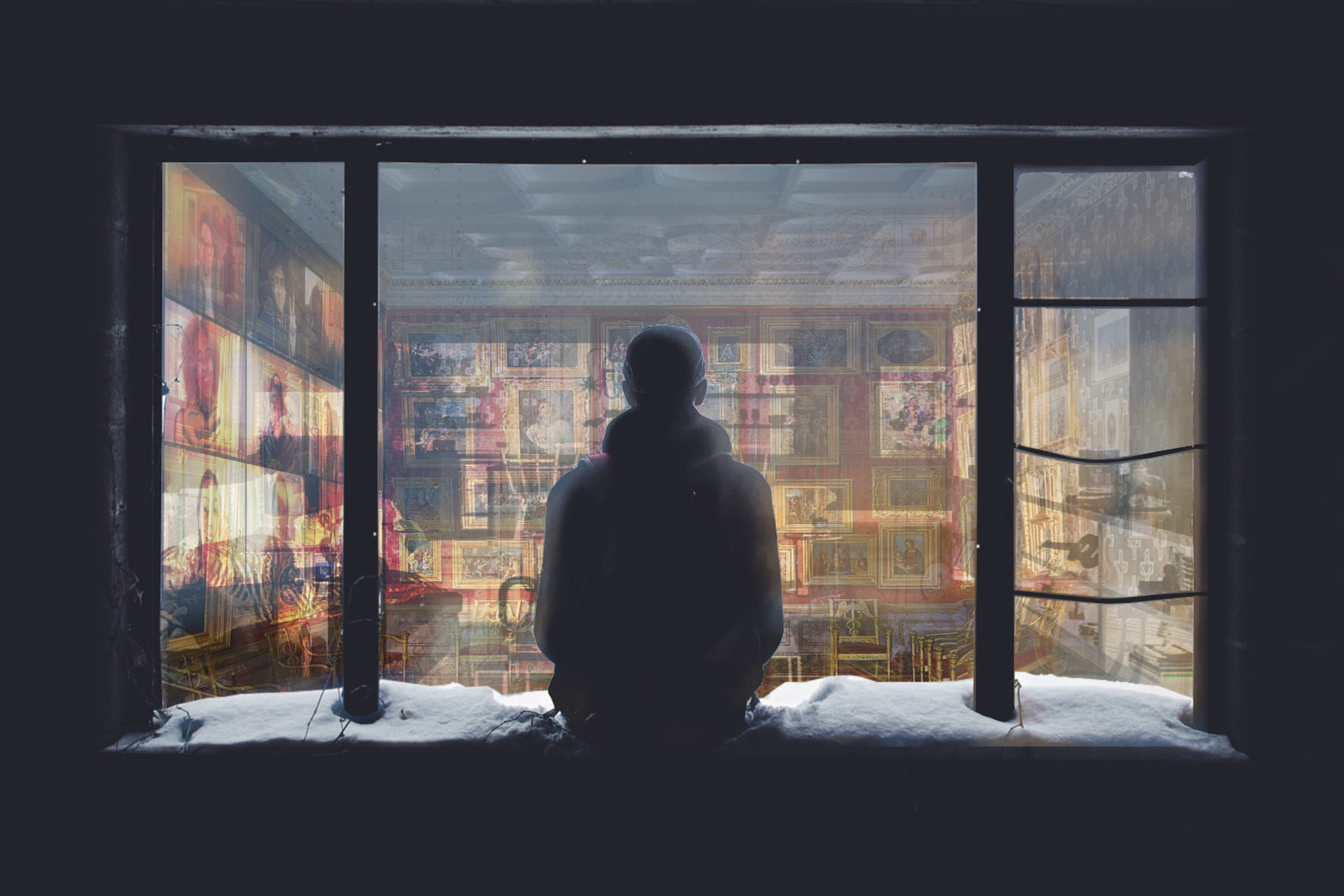 In this image, the artist poses an interesting question. What would it look like if your generic zoom windows overlapped with the windows of your home? What if the virtual rooms merged with your actual living spaces? Being able to peek into each other’s homes and would make every object in your background a lot more shareable, leading to new and interesting conversations. It would also allow you to keep visiting each other’s spaces and ideas and experiences. “This image depicts a shift of attention away from our cold and empty, increasingly generic exteriors, into an endless interior completely saturated with history and media,” Stoughton explained.
In this image, the artist poses an interesting question. What would it look like if your generic zoom windows overlapped with the windows of your home? What if the virtual rooms merged with your actual living spaces? Being able to peek into each other’s homes and would make every object in your background a lot more shareable, leading to new and interesting conversations. It would also allow you to keep visiting each other’s spaces and ideas and experiences. “This image depicts a shift of attention away from our cold and empty, increasingly generic exteriors, into an endless interior completely saturated with history and media,” Stoughton explained.
Woven Ground
By Arinah Rizal, Luke Kim, Qun Zhang
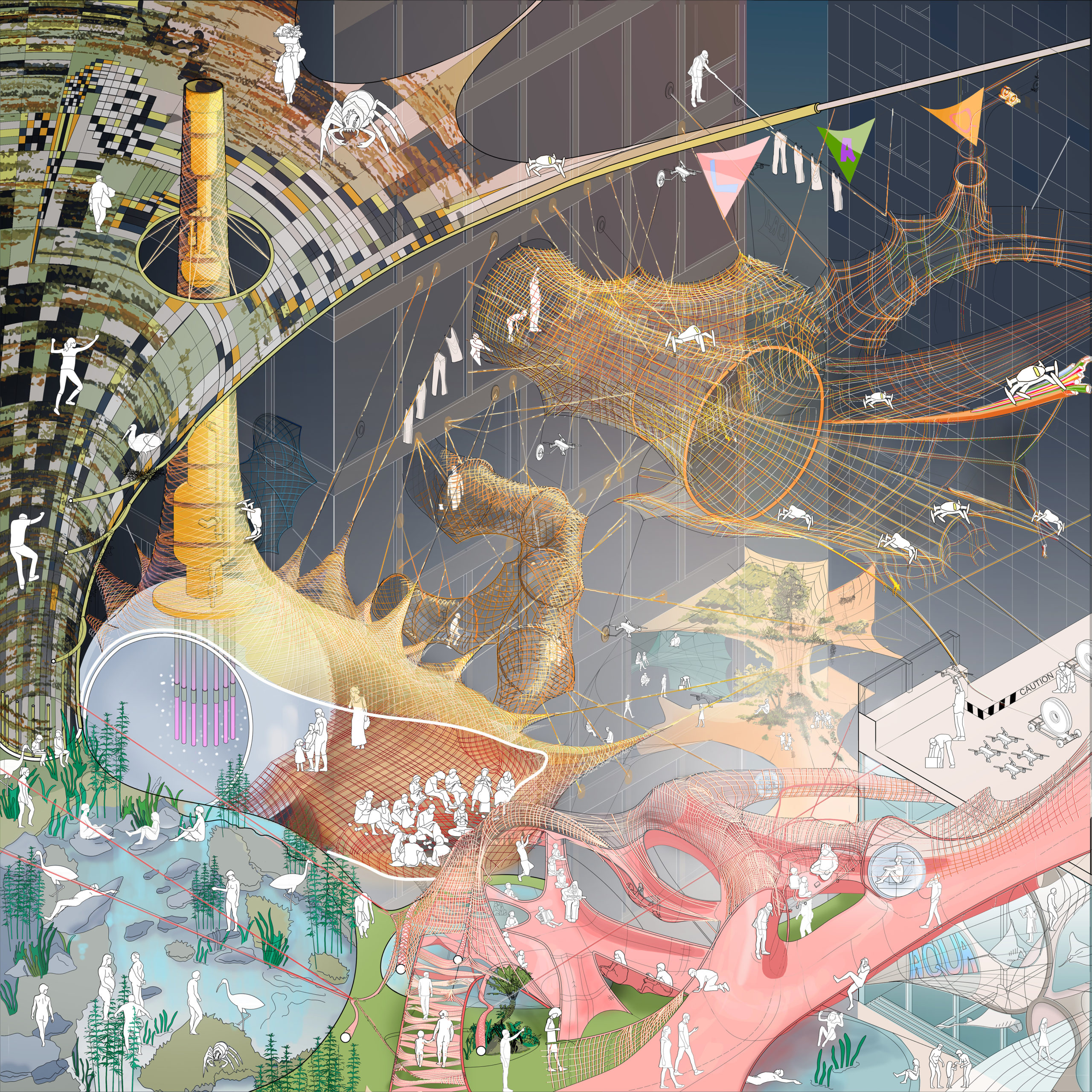 The artist examines the feelings of isolation faced by residents living in high-rise apartments in Melbourne. The frustrated residents of these towers come together to transform the empty spaces between these buildings by creating a robust net structure with the help of carbon fiber spinning robotic spiders. A yellow web begins at the base of the tower and grows outward to create a gathering area for young students, families with children and the elderly. “As they collectively weave in finer grains, this rich tapestry of organic forms is never complete, always adaptable, and able to accommodate for different forms of leisure, circulation, entertainment, and infrastructure,” they said.
The artist examines the feelings of isolation faced by residents living in high-rise apartments in Melbourne. The frustrated residents of these towers come together to transform the empty spaces between these buildings by creating a robust net structure with the help of carbon fiber spinning robotic spiders. A yellow web begins at the base of the tower and grows outward to create a gathering area for young students, families with children and the elderly. “As they collectively weave in finer grains, this rich tapestry of organic forms is never complete, always adaptable, and able to accommodate for different forms of leisure, circulation, entertainment, and infrastructure,” they said.
Perpetual Home
By Kate Korotayeva
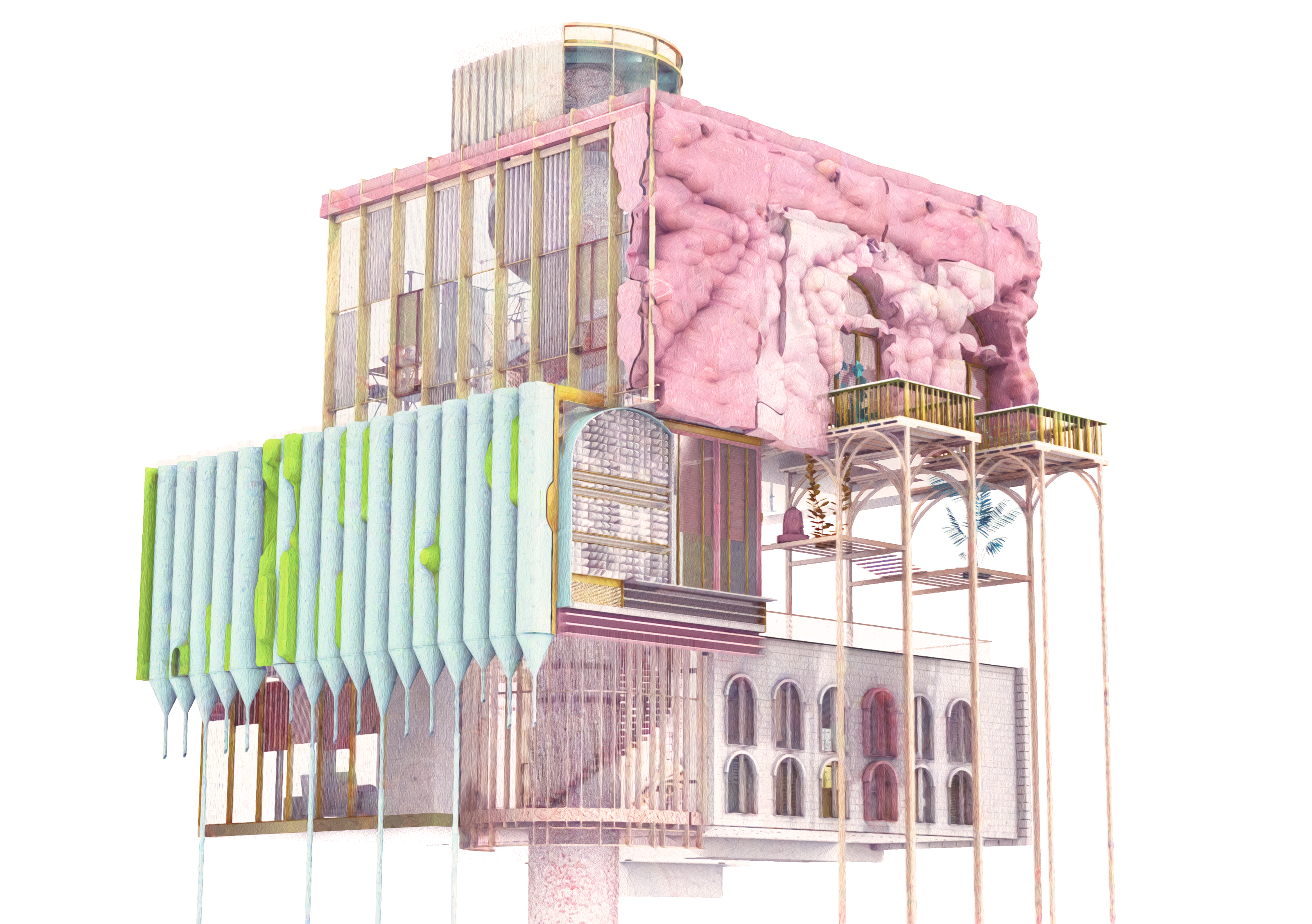 The illustration was created six months into the pandemic. The artist observed how the home slowly became the sole place for work, socializing, sex, creative endeavors and other needs of the homeowner. Korotayeva said, “This perspective of an imaginary and perpetually changing home emerges as a monstrous amalgamation of our hugely expanded bodies, technology, and built form.” She sees these changes as a tumorous growth that encroaches on the clearly defined boundaries of our homes and creates a new programmatic image.
The illustration was created six months into the pandemic. The artist observed how the home slowly became the sole place for work, socializing, sex, creative endeavors and other needs of the homeowner. Korotayeva said, “This perspective of an imaginary and perpetually changing home emerges as a monstrous amalgamation of our hugely expanded bodies, technology, and built form.” She sees these changes as a tumorous growth that encroaches on the clearly defined boundaries of our homes and creates a new programmatic image.
I’d Rather Be In Wonderland
By Margarita Andreeva
 In addition to the changing personal spaces, the pandemic also had a significant impact on the mental health of many around the world. The short-term negative feeling created due to isolation and social distancing can have long-term impacts on our mental health. The artist suggests mindfulness and creative exercises to help beat these feelings of loneliness. Art can help create an imaginary bubble to escape to, one that is limited only by imagination.
In addition to the changing personal spaces, the pandemic also had a significant impact on the mental health of many around the world. The short-term negative feeling created due to isolation and social distancing can have long-term impacts on our mental health. The artist suggests mindfulness and creative exercises to help beat these feelings of loneliness. Art can help create an imaginary bubble to escape to, one that is limited only by imagination.
The jury's votes are in — Architizer is proud to present the winners of the 2025 Vision Awards! Join the program mailing list and continue celebrating the world's best architectural representations by clicking here.



